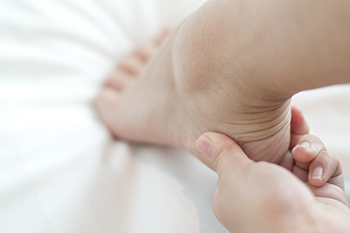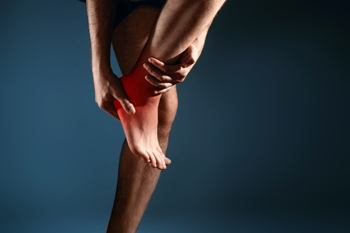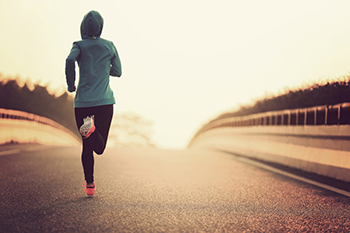Connect With Us
Blog
Items filtered by date: August 2022
Sever's Disease Affects Children and Young Teenagers

A common condition that can affect children and young teenagers who actively participate in sporting activities is known as Sever’s disease. This is an ailment that affects the heels, and can develop as a result of a heel growth spurt. The heel pain is caused by tight calf muscles or Achilles tendon, and the pain may increase when their chosen activities are pursued. You may notice your child is limping, walking on their toes, or experiencing swelling surrounding the heel. These symptoms may be indicative of Sever’s disease. It is beneficial to wear shoes that fit correctly, and this may help the affected foot to feel better. Effective treatment starts with stopping the activity that caused the condition. It is also important to elevate the foot as often as possible. The average recovery time for Sever’s disease is approximately 2-3 months. If your child has these symptoms, it is advised that you consult with a podiatrist who can effectively diagnose and offer treatment solutions.
Sever's disease often occurs in children and teens. If your child is experiencing foot or ankle pain, see Mack Jay Groves IV, DPM from Practice. Our doctor can treat your child’s foot and ankle needs.
Sever’s Disease
Sever’s disease is also known as calcaneal apophysitis, which is a medical condition that causes heel pain I none or both feet. The disease is known to affect children between the ages of 8 and 14.
Sever’s disease occurs when part of the child’s heel known as the growth plate (calcaneal epiphysis) is attached to the Achilles tendon. This area can suffer injury when the muscles and tendons of the growing foot do not keep pace with bone growth. Therefore, the constant pain which one experiences at the back of the heel will make the child unable to put any weight on the heel. The child is then forced to walk on their toes.
Symptoms
Acute pain – Pain associated with Sever’s disease is usually felt in the heel when the child engages in physical activity such as walking, jumping and or running.
Highly active – Children who are very active are among the most susceptible in experiencing Sever’s disease, because of the stress and tension placed on their feet.
If you have any questions, please feel free to contact our office located in Covington, LA . We offer the newest diagnostic and treatment technologies for all your foot and ankle injuries.
See Your Foot Specialist Regularly If You Work On Your Feet
Various Reasons That Flat Feet Can Occur

The medical condition known as flat feet exists as a result of little or no arch in the foot. It is easy to notice and can be seen by standing on the floor with the entire foot lying flat. It can be referred to as pes planus, or fallen arches, and most babies are born with this condition. It generally disappears as most arches are fully developed by the teenage years. There is a small percentage of patients who have flat feet throughout adulthood that may induce pain and discomfort. There are various types, and flexible flat feet are the most common. It is evident when the arch is visible as the foot is lifted. Additionally, a tight Achilles tendon may be a source of flat feet and often affects the arch. The heel can lift sooner than it should while walking and running, and it can cause pain and discomfort. If a foot injury occurs and the tendon that connects the inside of the ankle to the calf muscle becomes swollen or torn, the arch can be affected, possibly resulting in flat feet. If you have this condition, it is suggested that you are under the care of a podiatrist who can prescribe custom-made orthotics, which may help to strengthen the area where the arch normally is.
Flatfoot is a condition many people suffer from. If you have flat feet, contact Mack Jay Groves IV, DPM from Practice. Our doctor will treat your foot and ankle needs.
What Are Flat Feet?
Flatfoot is a condition in which the arch of the foot is depressed and the sole of the foot is almost completely in contact with the ground. About 20-30% of the population generally has flat feet because their arches never formed during growth.
Conditions & Problems:
Having flat feet makes it difficult to run or walk because of the stress placed on the ankles.
Alignment – The general alignment of your legs can be disrupted, because the ankles move inward which can cause major discomfort.
Knees – If you have complications with your knees, flat feet can be a contributor to arthritis in that area.
Symptoms
- Pain around the heel or arch area
- Trouble standing on the tip toe
- Swelling around the inside of the ankle
- Flat look to one or both feet
- Having your shoes feel uneven when worn
Treatment
If you are experiencing pain and stress on the foot you may weaken the posterior tibial tendon, which runs around the inside of the ankle.
If you have any questions please feel free to contact our office located in Covington, LA . We offer the newest diagnostic and treatment technologies for all your foot and ankle needs.
Baby Foot Care

Feet are critical parts of everyone’s body and babies are certainly no exception. If you are caring for a baby, there are several steps that you can take to ensure that their feet are healthy and taken care of. First, baby feet should not be physically restrained or restricted because physical activity and movement are what enable the baby’s feet to grow and develop. For example, when a baby kicks their feet, they are developing muscles in their feet. Second, ensure that any foot coverings your baby is wearing fit correctly. If your baby is wearing socks or booties when they are taken outside in cold weather, it might be smart to check regularly that they are not too tight. A baby’s body grows and develops at an astounding rate. Therefore, what fits a baby’s feet one month may not fit next month. Third, it can also be wise to regularly wash your baby’s feet to make sure that they are perfectly clean. However, if you do give your baby a foot bath be sure to completely dry their feet. If the feet are not dried properly, they could become soggy, which might create complications. If you are taking care of a baby, do not take any chances with the health of their feet. Contact your podiatrist for more tips and tricks about caring for baby feet.
Making sure that your children maintain good foot health is very important as they grow. If you have any questions, contact Mack Jay Groves IV, DPM of Practice. Our doctor can provide the care you need to keep you pain-free and on your feet.
Keeping Children's Feet Healthy
Having healthy feet during childhood can help prevent medical problems later in life, namely in the back and legs. As children grow, their feet require different types of care. Here are some things to consider...
Although babies do not walk yet, it is still very important to take care of their feet.
Avoid putting tight shoes or socks on his or her feet.
Allow the baby to stretch and kick his or her feet to feel comfortable.
As a toddler, kids are now on the move and begin to develop differently. At this age, toddlers are getting a feel for walking, so don’t be alarmed if your toddler is unsteady or ‘walks funny’.
As your child gets older, it is important to teach them how to take care of their feet.
Show them proper hygiene to prevent infections such as fungus.
Be watchful for any pain or injury.
Have all injuries checked by a doctor as soon as possible.
Comfortable, protective shoes should always be worn, especially at play.
If you have any questions please feel free to contact our office located in Covington, LA . We offer the newest diagnostic and treatment technologies for all your foot and ankle needs.
Pain in Different Parts of the Feet

Where pain is felt in the foot is sometimes a good indicator of its cause and whether medical treatment is necessary. Foot pain can originate from wearing uncomfortable shoes, prolonged standing, injuries, or chronic conditions, such as arthritis. Generalized toe pain can be from a hammertoe. Big toe pain can be from gout, broken bones, an ingrown toenail, or a sprain. Joint pain on a toe knuckle, ankle, or where the toes connect to the foot may be from arthritis. Pain in the ball of the foot can be from a strain, sprain, minor overuse, or Morton’s neuroma. Arch pain may be due to tendonitis, flat feet, or plantar fasciitis. Plantar fasciitis and tendonitis can also cause heel pain. Generalized foot pain or swelling may be from a blood flow issue, such as from diabetes or peripheral neuropathy. If you are experiencing foot pain and it does not resolve in a reasonable period with rest and perhaps a change to better fitting shoes, contact a podiatrist for proper diagnosis and a treatment plan.
Foot Pain
Foot pain can be extremely painful and debilitating. If you have a foot pain, consult with Mack Jay Groves IV, DPM from Practice. Our doctor will assess your condition and provide you with quality foot and ankle treatment.
Causes
Foot pain is a very broad condition that could be caused by one or more ailments. The most common include:
- Bunions
- Hammertoes
- Plantar Fasciitis
- Bone Spurs
- Corns
- Tarsal Tunnel Syndrome
- Ingrown Toenails
- Arthritis (such as Gout, Rheumatoid, and Osteoarthritis)
- Flat Feet
- Injury (from stress fractures, broken toe, foot, ankle, Achilles tendon ruptures, and sprains)
- And more
Diagnosis
To figure out the cause of foot pain, podiatrists utilize several different methods. This can range from simple visual inspections and sensation tests to X-rays and MRI scans. Prior medical history, family medical history, and any recent physical traumatic events will all be taken into consideration for a proper diagnosis.
Treatment
Treatment depends upon the cause of the foot pain. Whether it is resting, staying off the foot, or having surgery; podiatrists have a number of treatment options available for foot pain.
If you have any questions, please feel free to contact our office located in Covington, LA . We offer the newest diagnostic and treatment technologies for all your foot care needs.
Exercises and Preventing Running Injuries

Running can be an exciting and invigorating way to maintain your health and keep yourself in good shape. However, if you are not properly taking care of your body before, during, and after the run, you may be setting yourself up for a painful foot injury. One way in which you can be proactive in preventing potential running injuries is by performing foot and lower leg exercises. These exercises might help strengthen muscles and improve the agility of your feet when running, making injuries less likely. One exercise is known as calf stretches. Stand facing a wall and put both hands on the wall. Get into a lunge-like position. Slowly and slightly bend your back knee down so that you can lean into the wall. You will feel a gentle stretch in your upper calf. If you want to stretch the lower parts of the calf, you can perform this calf stretch exercise with both feet closer to the wall. You might consider performing this muscle-strengthening exercise shortly after a run. To stretch and strengthen your toes, you might perform the toe spread exercise. When you are in a seated position, wrap a rubber band around your toes. Spread your toes and hold the spread position for a few seconds. You can repeat this exercise on both feet several times. These are just some exercises that might help you prevent a running injury. For more information, reach out to a podiatrist.
Exercising your feet regularly with the proper foot wear is a great way to prevent injuries. If you have any concerns about your feet, contact Mack Jay Groves IV, DPM of Practice. Our doctor will treat your foot and ankle needs.
How to Prevent Running Injuries
Many common running injuries are caused by overuse and overtraining. When the back of the kneecap starts wearing out and starts causing pain in your knee, this is commonly referred to as runner’s knee. Runner’s knee is a decrease in strength in your quadriceps and can occur if you’re not wearing properly fitted or supporting shoes. To prevent runner’s knee, focusing on hip strengthening is a good idea, as well as strengthening your quads to keep the kneecaps aligned.
What Are Some Causes of Running Injuries?
- One cause of a common running injury is called iliotibial band syndrome.
- Plantar fasciitis is also another common injury.
- Stress fractures can occur from overtraining, lack of calcium, or even your running style.
Best Ways to Prevent Running Injuries
- Wear footwear that fits properly and suits your running needs.
- Running shoes are the only protective gear that runners have to safeguard them from injury.
- Make a training schedule. Adding strengthening exercises as well as regular stretching can help keep you strong and limber and can lessen the possibility of injuries.
- Stretching keeps muscles limber; this will help you gain better flexibility.
If you have any questions please feel free to contact our office located in Covington, LA . We offer the newest diagnostic and treatment technologies for all your foot and ankle needs.

